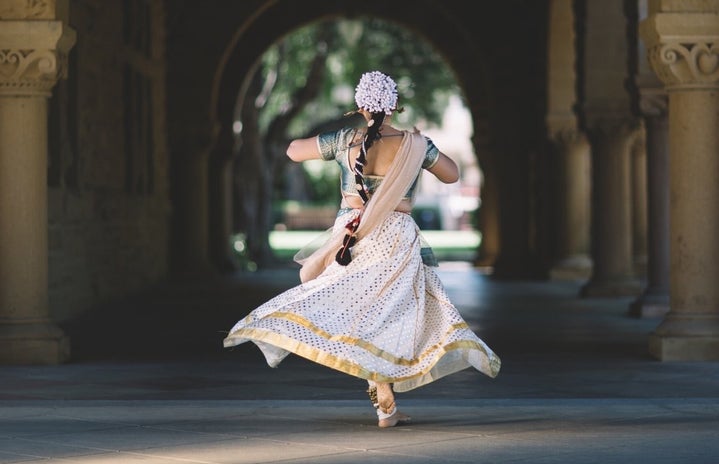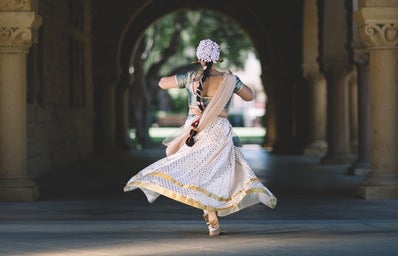Growing up, I never really questioned how cultured I was. I never thought I looked out of place, or wasn’t in touch with my Punjabi roots. I understood the language, often went to the Gurdawara (temple), watched Bollywood movies, and even had a majority of Indian friends. But over the years, my eyes slowly opened to the reality of things: I am just a “white-washed” Punjabi girl.
At 10 years old, I vividly remember playing out on the grass of my little elementary school. Mind you, almost everyone at this school knew each other since they were four years old. One of my classmates approached me and curiously asked “Why do you have that on your hand?”, pointing to my mehndi (henna). I excitedly explained how it was one of my family member’s weddings, and part of the week-long festivities is getting your mehndi done. The girl was shocked by the fact that I was explaining a typical Indian wedding that I was somehow a part of. All that came out of her mouth was,“But your name is Hannah”. Blushing nervously, I laughed and went about my merry way.
After that day, I would often question myself, asking why I didn’t appear Indian to a girl I had gone to school with for six years. I may have a typical Western first name, but my middle name is Kaur which translates to something along the lines of “princess” in Punjabi. I may not speak Punjabi, but I understand it all. My favorite meal is Chole Bhature (a delish garbanzo bean curry with fried dough). I love dancing and singing to “De de Gerha” at family parties. After school, I would listen to that staticy Punjabi Radio USA in the kitchen with my Bibi (grandma). So if these aspects of typical Punjabi culture are a huge part of my life, why would anyone assume I was anything else?
As years went on, I never really thought about how “Indian” I was on a daily basis. Occasionally, my parents would tease me about how terrible my Punjabi was, but I would quickly come back by stating how I understand every bit of the language, unlike my brothers. Or sometimes my Bibi would laugh at me for trying to speak Punjabi, but totally confusing the word for “study” with “brother”. Sometimes I would even try to roll out a roti (tortilla) that would come out totally lopsided, or say the forbidden words “too spicy”. All of these were just silly minor reminders of me being white-washed, but that’s because I’ve grown up in a western society with English speaking schools and friends who were the same level of “Indian” as me.
Eight years after being approached on the playground, I walked into the classroom of my Punjabi 1 lecture. Not only was I so nervous for this class because I was going to be the only senior in a freshman level class, but I was also haunted by the idea that these freshmen would laugh at me for my embarrassing level of Punjabi. That class really opened my eyes to the fact that I am indeed “white-washed” and there’s no way around it. Everyone in that class was Punjabi, with the exception of one Mexican girl. She and I sat at the very front of the class but never spoke a word unless asked. I was placed in the same category as someone who had no association with the culture at all. It really saddened me that I felt so far displaced from a culture that meant so much to me. Eventually I came around, started participating in conversations more, became the star student, and even though I still suck at speaking Punjabi, I’m proud that I made an effort to get closer to such an important part of my heritage.
As I came to UCLA, I knew that I would have no problem making friends that are similar to me. A land full of so many different people from so many different backgrounds made it so easy to find people similar to myself, or at least I thought. When I went to the Enormous Activities Fair my freshman year, the first booths I wanted to visit were Indian Student Union and Jakara Movement Chapter, since I was super involved in Sikh Honors Service Society in high school. I excitedly went to the ISU table, since it’s a group of all Indian students, not just Punjabis, which was so intriguing to me. I asked all my questions and listened to their spiel, and as I was leaving they hit me with “You should definitely join! We love to see non-Indian students interested in our club!”. When I tell you my heart actually dropped, I’m not exaggerating. I felt embarrassed, like I didn’t belong, and was just as confused as I was when I was 10 years old.
Even now from time to time, I get the usual “YOU’RE INDIAN?!” even from people that I’ve known for months or even years, and it doesn’t affect me quite as much as it did back then. It could be my pale complexion, the fact that my name is Hannah, my dislike for newer pop Punjabi music, my inability to speak a comprehensive sentence of my mother language, or not being in any Indian culture clubs. But, despite what everyone sees on the outside, I know that I am as Indian as I could be. No, I’m not half white. No, I’m not Persian. No, I’m not even a fraction of anything besides Indian. I proudly wear my ਕੜਾ (kara: bracelet) on my dominant wrist as a symbol of my devotion to Sikhism. I try to always sign my first, middle and last name on documents or applications so that it is evident that I have more to me behind my common first name. Although I may not look like a stereotypical Indian girl, and I’m extremely westernized, it doesn’t make me any less Indian. In honor of Asian American Pacific Islander Heritage Month, I encourage everyone to discover the beauty within themselves and their cultures.


